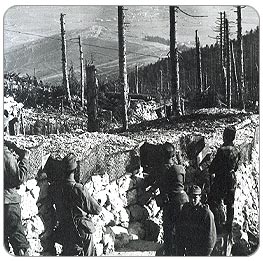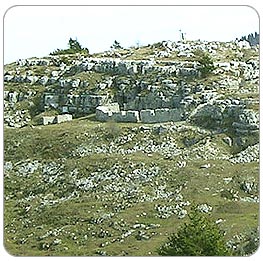|
Card
Mountain Zebio, thanks to its central position, became an important stronghold for the Austrian defensive line that (between 1916 and autumn 1918) made its way from Val d'Assa to Ortigara.
For such reason, it was equipped with a complex system of defense trenches, tunnels and cave posts that are still visible today.
During the summer of 1916 and most of all on the occurrence of the Battle of Ortigara (June 10th - 25th 1917) the Italian divisions repeatedly attacked the Austrian positions without any success.
The sadly recalled famous event of the mine (made by the Italians beginning in 1916 under the Lunetta's spur) that untimely exploded on June 8th 1917 at 17:30 (two days in advanced respect to the established date) perhaps due to a lighting strike, causing the explosion of the Austrian countermine as well and killing 120 Italian soldiers: together with more than forty officers of the Catania Brigate that were in that moment observing the Austrian positions from the Lunetta in prevision of the imminent Battle of Ortigara.
Staring from 1997 the Municipality of Asiago, within the implementation project of the Peace Trail (project permitted to benefit from the European contributions within the Objective 5b), began the restoration and the development of the Austrian positions of Crocetta dello Zebio (immediately overhanging Malga Zebio) and of the so-called Mina di Scalambron through the cleaning and reinforcement of a resistance trench segment and of the mine crater, the restoration of the posts, of the gravestones and of the barracks positioned in the immediate rear and the installation of tables and explicative charts.
Furthermore, near the Stalder shelter was built, on the traces of the old Italian walkway, a trench segment for didactic purposes made up of trench sections "types" deduced from research documents of the time and in particular from the instructions issued by the military engineers.
Lastly, the ex military cemetery has been put back where numerous fallen soldiers of the Sassari Brigade have been buried and more south, the remains of the Italian sector command.
All of the area under to the intervention umbrella which aims at recuperating the museum, is connected by a ring passageway that allows a simple and safe visit.
The open air museum of Mount Zebio represents the first significant example of a tourist - didactic restoration and development project of the works remains of the Great War. Interventions that could find, within a wider project in process of being drafted, their natural completion under a structural point of view as well as under a promotional and utilization point of view.
Monte Zebio
Austro-Hungarian defense system made up of trenches with annexed walkways, rock excavated posts and cave shelters connected between Crocetta and Zebio and the region of Mina di Scalambron
Trench remains and Austro-Hungarian shelters in the region of Pastorile dello Zebio
Service caverns and access tunnels to the mine
Austro-Hungarian gunner cavern under the trench west to the Scalambron mine
Cave post "feritoia 14"
Barracks remains and medication post north of Stalder shelter
Command barracks remains of the Sassari brigade south of the Italian cemetery
|
 -
-
|
 -
-
|
  
|